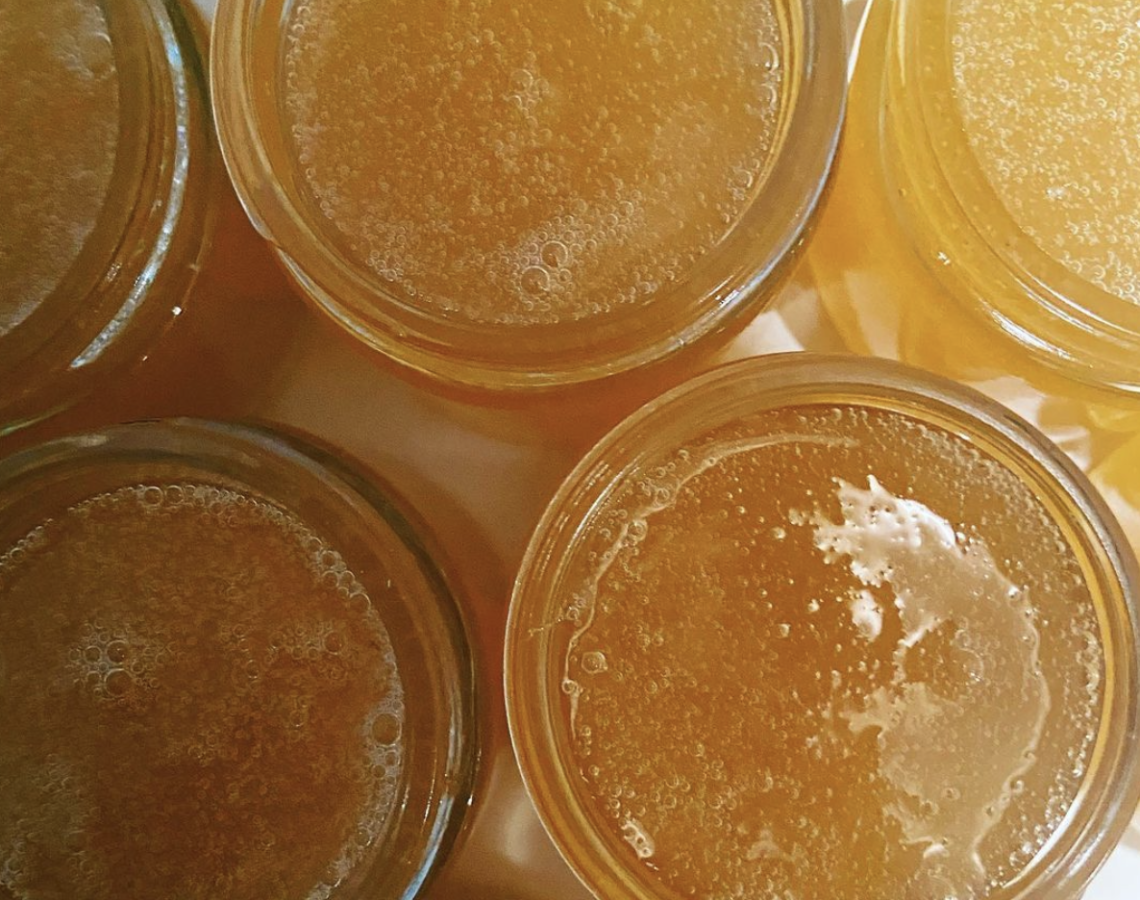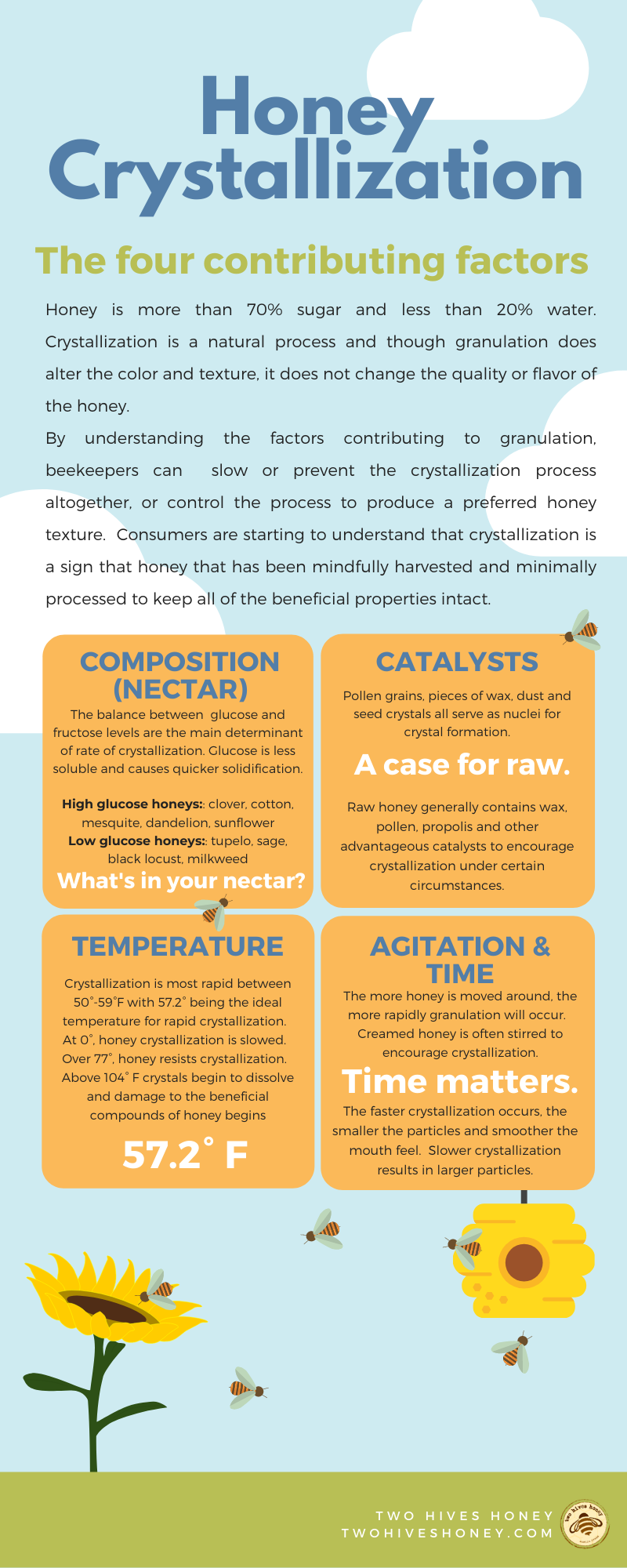Has My Honey Gone Bad? Why Crystallized Honey is a Good Thing!

We spend a lot of time educating our customers about bees and about our honey. Our product looks a little different from what you may be used to finding in the grocery store. We have a rainbow of colors (and flavors!) each season, and it often starts to turn to a solid pretty quickly after you take it home. What’s that all about?!
When you notice your jar of Two Hives honey starting to change state, that is what is called crystallization. Crystallization of honey is completely natural and does not change the quality or flavor of the honey (though a new texture may tell your brain it tastes a bit different!). This change of states is what happens to raw, unfiltered and unheated honey.
Let’s get a bit geeky with some science (if you’re not into science, just skip this paragraph!). Honey is a supersaturated solution of sugars. It contains more than 70% sugars and less than 20% water. In other words, the water found in your honey contains more sugar than it can naturally hold. This overabundance of sugar makes honey unstable, and nature doesn’t like instability and will always try to reach equilibrium. Your honey’s efforts to reach an equalized state result in crystals beginning to form in the honey, causing it to thicken and eventually become solid.
But not all honey will crystallize at the same rate or result in the same texture. Four conditions affect how fast the crystals form and how large they will be:
Composition: The two major sugars found in honey are glucose and fructose, and the percentage of each will determine how quickly a honey will crystallize. Because glucose is less soluble than fructose, honeys that are higher in glucose will crystallize more rapidly. Conversely, honeys higher in the more water soluble fructose will crystallize more slowly.
Temperature: Honey held at very high temperatures and very low temperatures will crystallize more slowly, or not at all. One of the reasons most grocery store honeys will not crystallize is because they have been pasteurized, which requires high heat. The most ideal temperature to induce crystallization is 57F–the further you get away from that number on either side, the slower a honey will crystallize.
Catalysis: The honey has to have catalysts, or nuclei, for the sugar crystals to form around. This can be tiny microscopic bits of pollen, beeswax, or propolis. Another reason the grocery store honeys will not crystallize is because they have been heavily filtered. This is done to prevent crystallization altogether, but the issue is that now the honey is no longer raw and is missing a lot of the inherent health benefits that come with eating raw honey. Basically, you’re now just left with the sugars.
Agitation and Time: More agitation can cause honey to crystallize more quickly than it would if left undisturbed.
Some honeys will crystallize very rapidly, and others will have a smoother or a rougher texture. For example, our mesquite honey crystallizes extremely quickly and results in a grainy, sugared texture. Meanwhile, our fall honey will crystallize very slowly and have a smoother texture.
My honey has crystallized, now what!!
TLDR: please don’t think crystallization means your honey has spoiled! The benefits of crystallized honey include:
- If your honey has crystallized, it’s a good sign that you purchased real, raw honey, chock full of the health benefits that come with an unpasteurized product.
- Crystallized honey is way less messy to use!
- Spreading crystallized honey on a really hot piece of bread or biscuit is delicious, as the heat of the bread allows you to experience the honey melting on your tongue in a really glorious way.
- The texture of crystalized honey can bring a whole new experience to dishes. For example, when you stir liquid honey into oatmeal or yogurt, a lot of the experience is lost as the honey now simply acts as a sweetener. But when you top oatmeal with crystallized honey, it holds its texture and shape and allows you to customize each bite with more or less honey. The crystallized texture is fun to pair with other textures such as granola and fruit.
Of course, if you want or need your honey to be liquid once again, it’s easy to achieve. First, resist the temptation to put your honey in the microwave or in a pot of boiling water! We never want to heat our honey above 100℉ to preserve its health benefits, and you will get there quickly with these methods. Keeping your honey in a warm sunny window can keep it liquid longer, or placing the jar in a pot of hot–NOT boiling–water off of the heat can provide a quick solution. Just keep in mind–liquify just what you need, as the honey will eventually crystallize again!
What about that creamed honey I’ve been hearing about?!
To make our creamed honey, we have taken control over 3 of the 4 conditions that we know contribute to crystallization–temperature, catalysts, and agitation. In a nutshell, we use a little seed honey whose buttery texture we love, and combine it with a much larger amount of our uncrystallized honey. At a carefully controlled temperature, the crystals that form in the new honey will be the same size and texture as those in the seed honey, producing that creamy texture that’s an instant customer favorite. You can find both our spring and fall creamed honeys on our website. All of our other honeys we allow to crystallize naturally.
I hope this mini education has helped dispel some of those strongly held myths about crystallized honey. The next time your honey turns from liquid to a more solid state, take a moment to express gratitude knowing that your honey is truly raw and brings with it so many wonderful health benefits. Check out this fun infographic we put together summarizing the science behind crystallization.




Leave a Reply